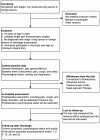Postoperative chronic operation-related symptoms after minimally invasive lung surgery: a prospective observational protocol
- PMID: 39097304
- PMCID: PMC11298735
- DOI: 10.1136/bmjopen-2023-082412
Postoperative chronic operation-related symptoms after minimally invasive lung surgery: a prospective observational protocol
Abstract
Introduction: Significant numbers of patients undergoing minimally invasive lung surgery develop chronic symptoms such as chronic pain and chronic cough after surgery, which may lead to a reduced quality of life (QoL). Despite this, there remains a dearth of high-quality prospective studies on this topic. Therefore, our study aims to systematically investigate the incidence and progression of long-term chronic symptoms following minimally invasive lung surgery, as well as changes in patient's psychological status and long-term QoL.
Methods: This is a single-centre, observational, prospective study that included patients with stage I non-small cell lung cancer or benign lesions. Prior to surgery, patients' baseline levels of chronic pain, chronic cough and sleep will be documented. Anxiety, depression and QoL assessments will be conducted using the Hospital Anxiety and Depression Scale (HADS) and the European Organisation for Research and Treatment of Cancer (EORTC) 30-item QoL Questionnaire (QLQ-C30). Following surgery, pain and cough will be evaluated during the initial 3 days using the Numeric Pain Rating Scale and Visual Analogue Scale score, with assessments performed thrice daily. Additionally, sleep status will be recorded daily during this period. Subsequently, postoperative chronic symptoms and QoL will be assessed at weeks 1, 2, 4, 12, 26 and 52. Chronic cough will be evaluated using the Leicester Cough Questionnaire, chronic pain will be assessed via the Brief Pain Inventory and McGill Pain Questionnaire while the EORTC QLQ-C30 questionnaire and HADS will provide continuous monitoring of QoL, anxiety and depression statuses. Data will also include the timing of chronic symptom onset, predisposing factors, as well as aggravating and relieving factors.
Ethics and dissemination: Ethical approval was obtained from the Ethics Committees of Fujian Medical University Union Hospital. The findings will be disseminated in peer-reviewed publications.
Trial registration number: NCT06016881.
Keywords: hospitalization; lung diseases; mental health; nursing care; pain management; thoracic medicine.
© Author(s) (or their employer(s)) 2024. Re-use permitted under CC BY-NC. No commercial re-use. See rights and permissions. Published by BMJ.
Conflict of interest statement
Competing interests: None declared.
Figures
References
Publication types
MeSH terms
Associated data
LinkOut - more resources
Full Text Sources
Medical

